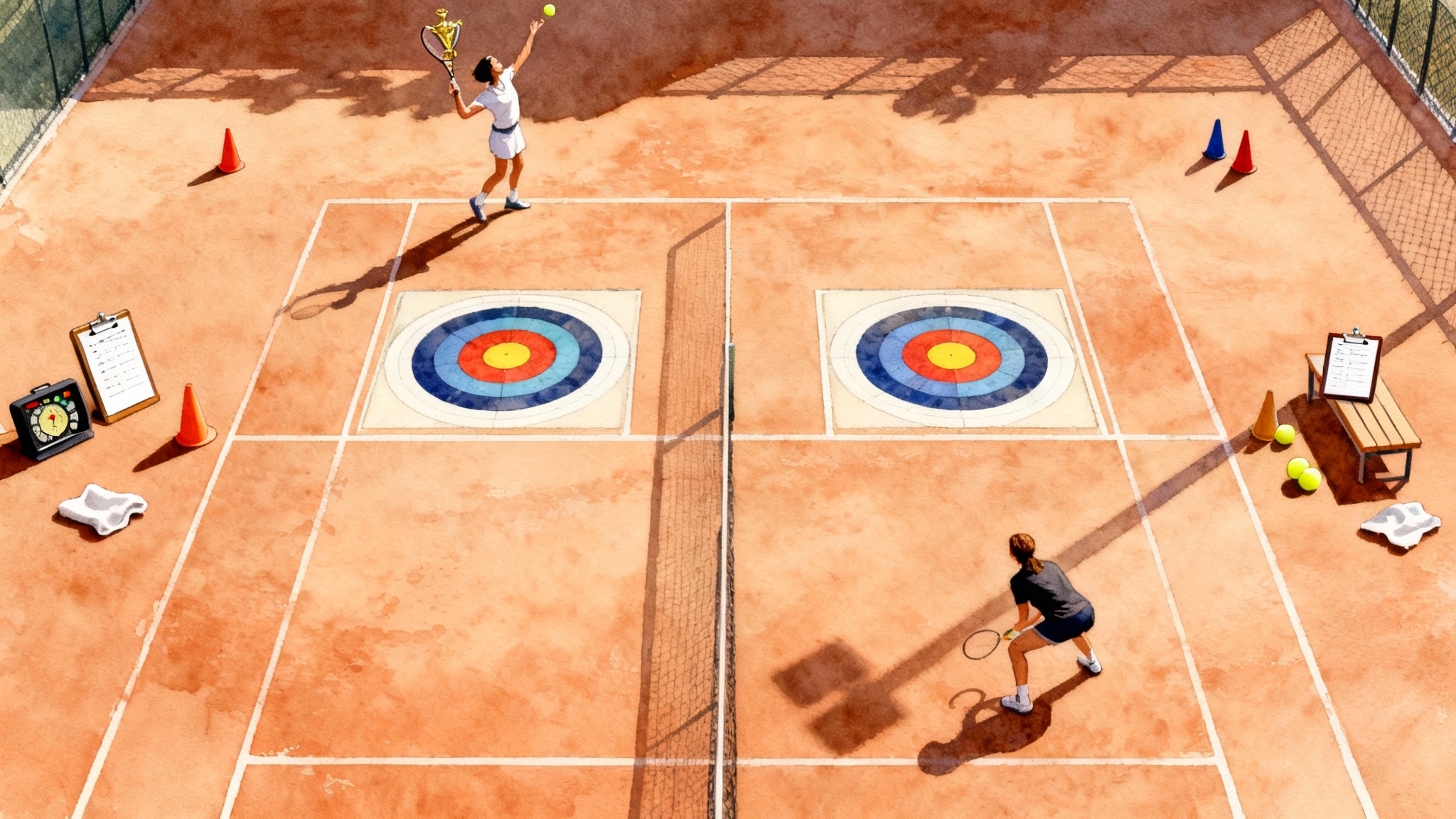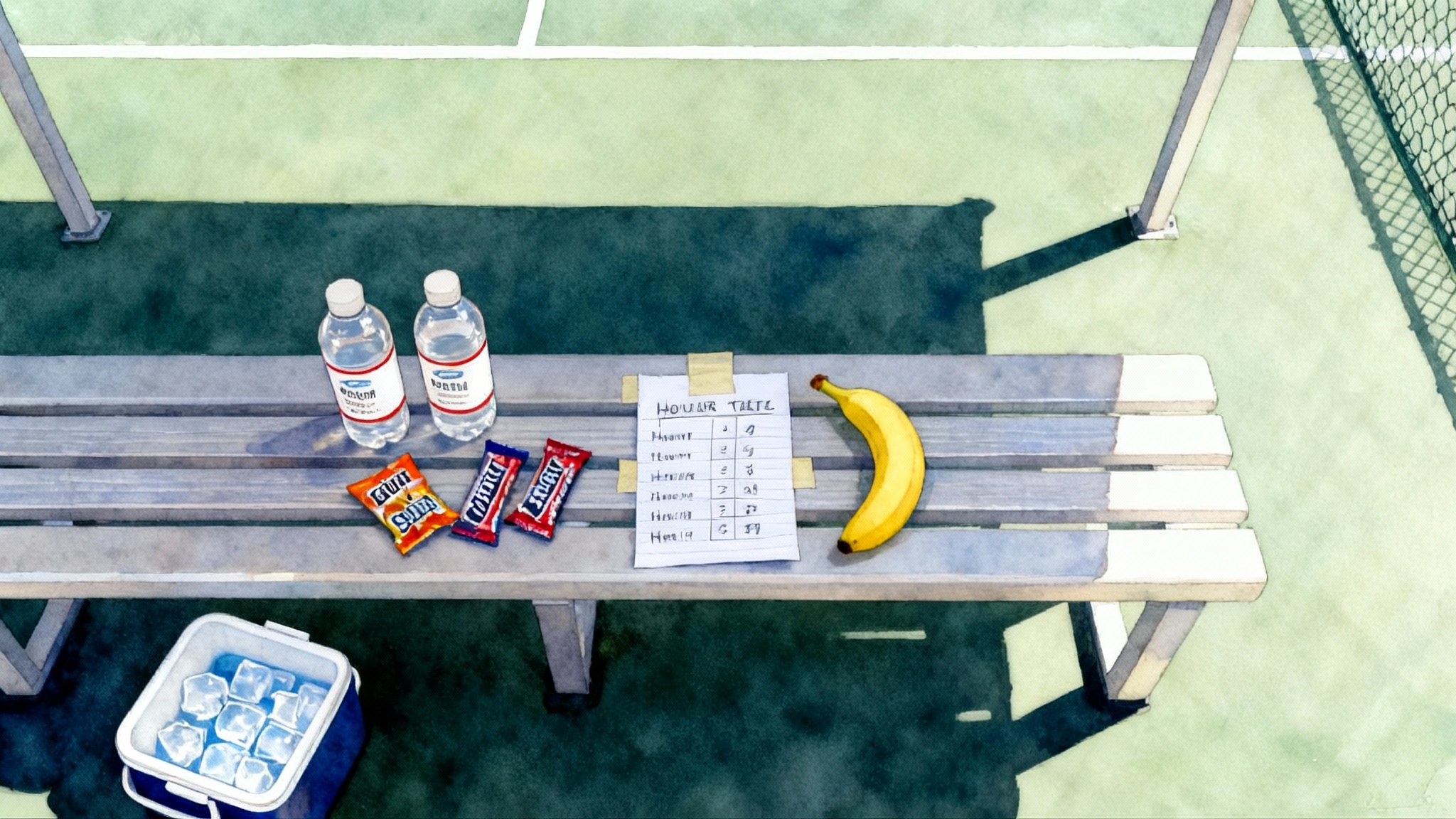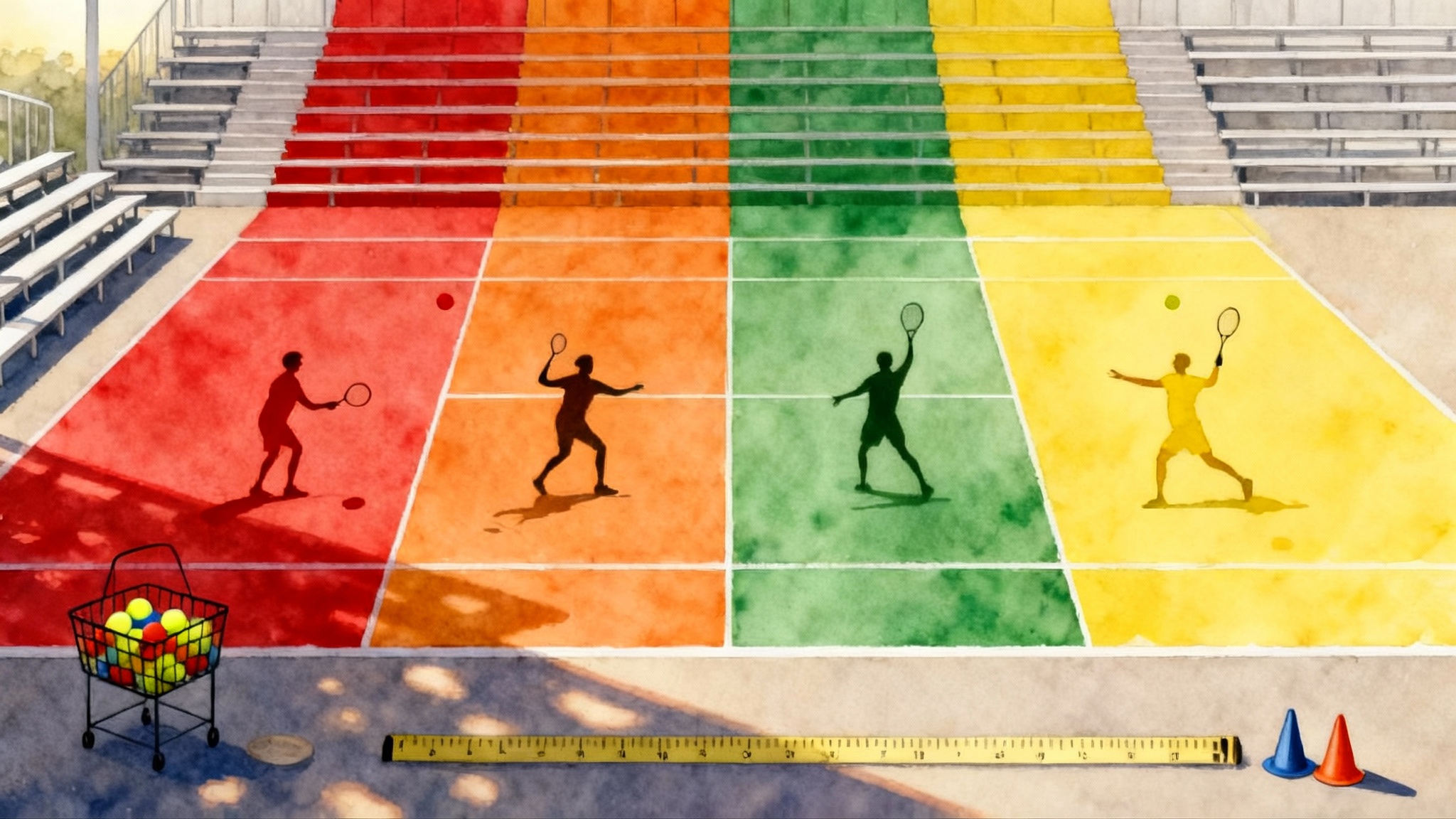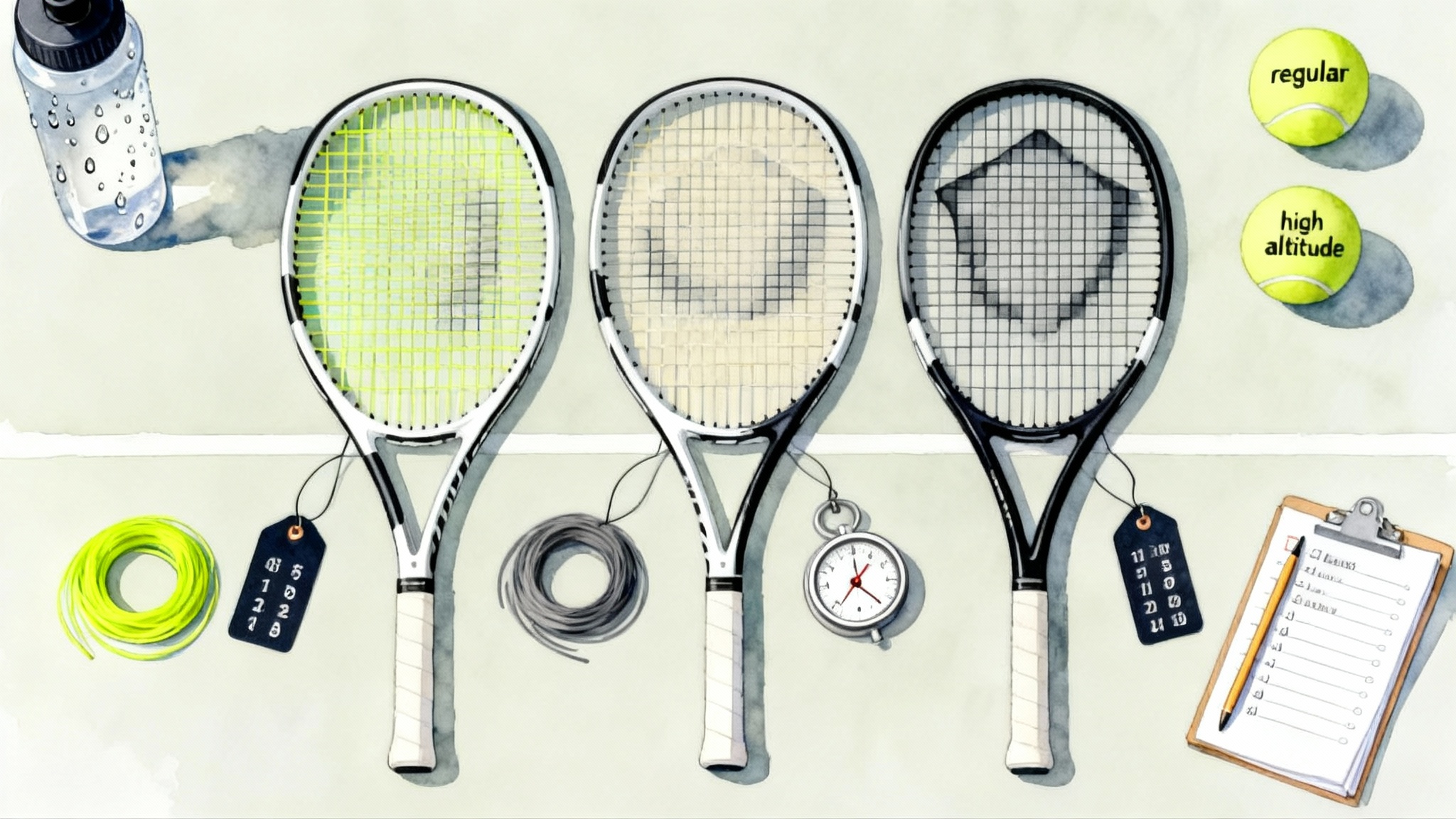Second Serve Mastery: Spin, Targets, and Pressure Drills
A practical, age-smart guide to building a reliable second serve without rewriting your motion. Learn continental grip and pronation progressions, safe shoulder mechanics, bullseye target maps, and match-like pressure games for juniors and adults.

Why the second serve decides more than you think
If your second serve stands up under pressure, the rest of your game relaxes. Returns come shorter, rallies start on your terms, and you stop giving away the most expensive point in tennis: the double fault. For juniors, a dependable second serve signals readiness for tougher tournaments. For adult league players at 3.0 to 4.5, it turns close sets into wins because you stop gifting free points in the tightest moments. Pair your serve work with our 2025 weekly blueprints to fit real schedules. For college coaches and for the professional pathway in the Association of Tennis Professionals and the Women’s Tennis Association, your second serve is a reliability marker. It shows you can start points with a plan rather than a hope.
This guide gives you a road map to second serve mastery without replacing your motion. The goal is not a brand new serve. The goal is a cleaner base, better spin, smarter targets, and proven pressure drills that hold up when the score is ugly.
Build the base: grip, toss, and safe shoulder mechanics
Think of the second serve as a hammer that drives in the same nail every time. The hammer must be held correctly, the swing path must be repeatable, and your body has to stay safe.
The continental grip, explained and installed
- What it is: Place the heel pad of your hand on the top beveled edge of the handle so your racquet face is neither open nor closed at address. The index knuckle sits on bevel two. This is the continental grip.
- Why it matters: It allows your forearm to pronate through contact. That creates spin and keeps the strings aligned to the target even when you brush the ball. Eastern forehand grips lock the face and make the racquet swing across the ball, which reduces spin and stresses the elbow.
- How to install it: Hold a hammer, then pick up the racquet the same way and do 50 shadow swings without a ball. If the racquet feels unstable, add a light squeeze at the moment you hear the “whoosh,” then relax again. Alternate squeeze and relax so you learn to load and release, not strangle the handle.
A consistent toss that helps spin
- Location: For a kick or slice second serve, keep the toss a little closer to your head and slightly behind the baseline of your front foot. If you drew a line straight up from your front toes, the ball should pass just inside that line.
- Height: Toss high enough that you reach full extension without jumping wildly. If you jump to find the ball, the toss is too far forward or too low.
- Drill: Stand with your back foot against a fence. Toss and catch 30 times so the ball peaks above your hitting shoulder and drops within easy reach without pulling your chest forward. If your hat brim crosses the fence line, the toss drifted forward.
Shoulder-safe sequencing
Second serves use more external rotation and pronation than flat serves, which can tempt players to contort their backs and yank their shoulders. Keep it safe with these cues:
- Balanced base: Start with feet just wider than hips. Keep your chest stacked over your hips to avoid excessive back arching. Think tall through the crown of your head.
- Trophy position: Racket hand near ear height, elbow roughly level with or slightly below the shoulder. Hitting forearm vertical, non-dominant arm extended upward to help you stay lifted.
- Drop to rise: Allow the racquet to fall behind your back as your chest stays tall. Lead with your hip toward the court, not your lower back.
- Pronation to finish: After contact, let the forearm rotate so the strings face the side fence, then allow your arm to decelerate across your body. Finish with a soft elbow and the racquet near your opposite thigh or hip, not locked behind your back.
If any move causes sharp pain, stop and reduce range or see a qualified coach or medical professional. Safe mechanics are the foundation of long-term serving.
Pronation progressions you can feel
Pronation is forearm rotation that squares the strings even while you brush the ball. Most players think they must “snap the wrist.” What really creates the snap is a coordinated chain: legs and trunk drive up, the shoulder rotates, the forearm pronates, and the wrist stays loose.
Use these progressions:
- Hand-only screwdriver: Hold a pen lightly and twist as if turning a screwdriver. That is pronation and supination. Feel how it comes from the forearm, not a wrist flick.
- Half-serve throws: From a trophy position without a ball, swing up and turn your palm from facing left to facing right if you are right-handed. Listen for the whoosh at contact height. Do three sets of 15.
- Foam ball serves: Use a red or orange training ball. Aim for six feet of net clearance. Your goal is a heavy arc that lands deep. If the ball flies long, you are pushing rather than brushing. If it sits short, increase racquet speed but keep the same brushing feel.
- Down-the-line brush: Stand on the ad side. Aim your swing path up the back of the ball toward the side fence, not across your body. The ball should curve left to right if you are right-handed. Ten in a row before moving back to normal positioning.
Spin first, then speed
A reliable second serve is built like a campfire. You build the structure, light a small flame, then add logs. Spin is the structure. Speed is the log you add last.
- Start with margins: Six to eight feet over the net and deep middle is your default target.
- Add axis control: Practice a kick version that jumps up and a slice version that moves sideways. See which one you trust when nervous. You do not need both on day one, but you need one that shows up under stress.
- Only then add pace: When your error rate is under two misses in every ten, add ten percent more speed by increasing leg drive and trunk rotation, not by yanking the arm.
Bullseye target maps that teach placement
Draw a bullseye in each service box using flat cones or chalk. Think of three rings:
- Outer ring, big: Safe landing zone. Worth 1 point.
- Middle ring: Tactical sweet spot. Worth 2 points.
- Inner ring, small: High reward. Worth 3 points.
Create four specific maps and rotate them:
- Deep middle on both sides: Stabilizes your pattern. This is your rainproof second serve.
- Body to the backhand: Jam the returner. Aim halfway between the center mark and the sideline, just inside the service line.
- Wide on the deuce side: Slice that pulls the returner off the court.
- T on the ad side: Kick that lands near the center line and jumps into the body or backhand.
Scoring ideas:
- 21 with rings: First to 21 points. You only score on serves that would be in. Misses score zero, not negative.
- Make it twice: You must land a 2-point target two times in a row before moving to the next box.
- 2 in 3 rule: Every set of three serves must include two safe makes into the outer ring. If you miss twice, you restart the set.
These maps teach you to build the rally on your terms and to escalate risk only when the score justifies it.
Pressure drills that make practice feel like a tiebreak
Any second serve that is only good in warmups will fade the moment the scoreboard matters. Pressure drills force your brain to deliver when your legs tremble.
- Three-ball gauntlet: You get three balls per side. You must land all three second serves into your chosen map. If you miss one, you go back to ball one. The third ball is always under simulated pressure.
- 10 to close: Serve only second serves to a partner who calls in or out. Start at zero. Makes are plus one. Misses are minus one. You must finish at plus ten. The last two serves must be to a 2-point bullseye.
- Deuce or ad lockdown: Play a practice set where every point starts on deuce or ad court only, and you can only hit a second serve. This repeats the same sight picture and builds confidence on your weaker side.
- Serve plus one: After a second serve, your partner feeds a neutral ball to start the rally. You must hit your planned plus-one shot to a defined target. For example, deep crosscourt to the backhand. Link this habit with our guide to smart first four shots.
- Miss and move: Every miss requires a 10-second physical reset such as quick-feet ladder or side shuffles, then back to the line. You learn to breathe, reset, and deliver, not stew on the miss.
Time your sets and write the best times in a notebook. If you do not measure, you guess. Guessing rarely beats nerves.
Parent-assisted at-home second serve builders for juniors
Parents can help without turning the driveway into a lecture hall. Use props and clear goals.
- Towel pronation snaps: Tie a knot in a small towel. Hold with a continental grip. From trophy position, swing up and let the towel snap forward as the forearm turns. Listen for a clean whoosh. Three sets of 15, rest between sets.
- Football spiral throws: Use a junior football. Stand in a serve stance and throw a spiral up and forward. A clean spiral shows good pronation and release. Do 20 throws, then 10 shadow serves.
- Laundry basket toss target: Place a basket at shoulder height on a chair two feet in front of the baseline. Toss the ball so it peaks above the basket and would drop in. Ten perfect tosses before moving on. If the ball drifts forward, step back and reset.
- Chalk footprints: Draw foot outlines for a balanced stance. Junior steps in, shadow serves three times, steps out. This builds routine.
- Fence brush: Stand one racket length from a chain-link fence. Brush up without touching the fence. Ten in a row teaches a vertical path.
Keep sessions short. Fifteen focused minutes beats an hour of nagging. Praise the process metrics: balanced stance, clean toss, whoosh sound, and high net clearance.
Adult league adaptations for 3.0 to 4.5
Different levels need different constraints.
- 3.0: Build height and shape. Target the deep middle with six to eight feet of net clearance. Use foam or green dot balls at first to exaggerate spin. Goal: 7 of 10 makes under time.
- 3.5: Add slice away from the body on the deuce side. Keep the same height but learn to start the arc outside the post and bring it back in. Goal: Alternate deep middle and deuce wide for five successful pairs.
- 4.0: Add a kick to the ad side that climbs into the backhand. Practice from a half step wider to open the angle. Goal: Serve two to the ad kick, then one body, repeat to 18 total serves.
- 4.5: Layer disguise. Use the same toss and stance, but vary axis slightly. Alternate kick ad and body deuce without changing tempo. Track double faults in practice sets and aim for fewer than one per service game across three sets.
Weekly plan for adults:
- Day 1 mechanics: 30 minutes of continental grip and pronation progressions, then 15 minutes of bullseye maps.
- Day 2 pressure: Three-ball gauntlet and 10 to close. Finish with a practice tiebreak that allows only second serves.
- Day 3 link-up: Serve plus one patterns with a hitting partner or ball machine. Record your two safest patterns.
- Day 4 review: Short mechanics check, then match play where every first serve is replaced by your second serve. Learn to compete with your safety net.
Readiness marker for college and the pro pathway
College coaches and academies look for a second serve that meets four criteria:
- You make the serve at a high rate under pressure. Scrimmages and tiebreaks tell the truth.
- You vary spin axis and location to avoid patterns that good returners attack.
- You link it to a plus-one plan, not a defensive bunt.
- Your motion is efficient and safe, not forced or painful.
If you can check these boxes, you can compete at higher levels. Power is valuable, but reliability is the floor that lets your weapons breathe.
Case study: Westchester pressure tests that travel
At Tennis Innovators Academy in Westchester, coaches use Universal Tennis Rating match play to translate practice to results. The format is simple and brutal, which is the point. Players enter tournament-style sets where every first serve must be a second serve for the first four games of each set. Miss two second serves in a single game and you start the next game at love fifteen. The bullseye maps sit on the court, and players must hit at least two 2-point targets per service game or they run a short shuttle and try again.
Why it works:
- The scoreboard is real, not a drill. Nerves show up. You learn to manage them.
- Targets are visible. If you beat your target, you own the result, good or bad.
- Consequences are immediate and small. You reset quickly and try again. This mirrors competitive tennis where the next point arrives fast.
Players log makes, misses, and target hits after each set. Over three to four weeks, the double fault count drops, and the plus-one ball becomes more predictable. The skill survives travel because it was forged in a scoring environment, not just a basket drill.
Troubleshooting: quick fixes that actually work
- Misses long: Your toss is too far forward or your swing path is too level. Move the toss slightly back and brush more up the back of the ball.
- Misses in the net: Contact is too low or your arm is tense. Raise contact by waiting a touch longer and loosen the hand for a cleaner whoosh.
- Sidespin that curves out: Your grip has drifted away from continental. Recheck hand position and do 10 towel snaps.
- Stiff elbow pain: Reduce range in the racquet drop and shorten your practice set. If pain persists, consult a professional.
- Toss chase: You are running after the ball. Do 20 basket toss drills to re-center the ball over your front foot line.
A four-week progression to lock it in
Week 1: Mechanics and map
- Daily 15 minutes of continental grip and pronation progressions.
- Bullseye Map 1: Deep middle only. 60 total serves across two sessions. Target 70 percent makes with high net clearance.
Week 2: Axis and control
- Add slice on deuce side or kick on ad side. Keep Deep middle as your base.
- Pressure set: Three-ball gauntlet to 5 perfect sets. If you miss, restart that set.
Week 3: Link serve to plus one
- Serve plus one patterns. Choose two plays and run 30 reps each: ad kick then forehand to open court, deuce slice then backhand deep middle.
- Pressure set: 10 to close with the last two to a 2-point target.
Week 4: Compete your habit
- Two match-play sessions where every first serve is a second serve for the first four games. Track double faults and 2-point target hits.
- End-of-week test: Play a tiebreak that allows only second serves. Target two or fewer double faults and at least four 2-point hits.
If you hit the goals, add speed by driving up with the legs, not by forcing the arm. If you miss the goals, repeat the week. Progress is earned, not gifted by the calendar.
Bring it together
A reliable second serve is not a mystery. It is a handful of skills that you can build in order: continental grip, toss you can trust, pronation you can feel, spin before speed, targets that teach choices, and pressure that makes it real. Juniors can grow these habits at home with simple tools and clear wins. Adult league players can structure short sessions that fit busy lives and deliver fewer double faults on league night. College coaches and high-performance pathways watch for this exact reliability because it predicts battle-ready points. Build your second serve like a craftsperson, piece by piece, then test it under a scoreboard. When the next tiebreak arrives, your calm will feel earned.







